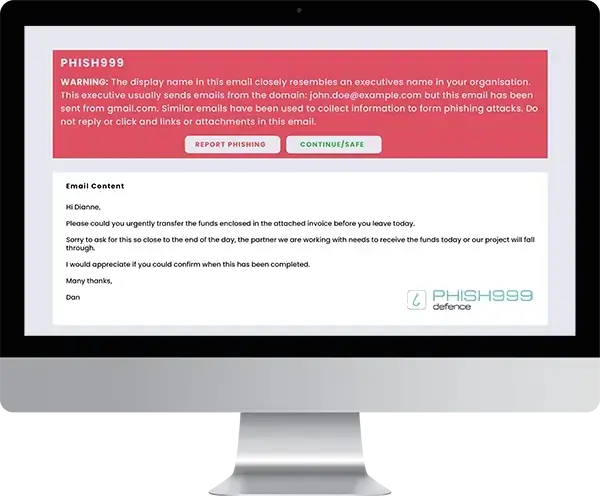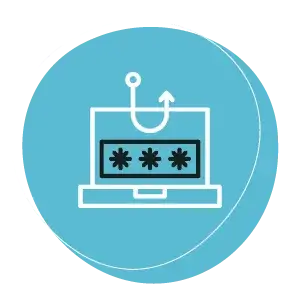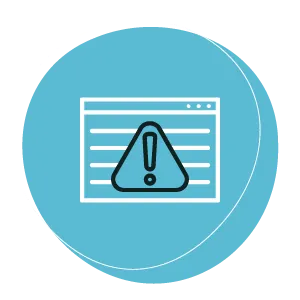Phish999 Phishing Protection Service
Regardless of your current email security solutions, how many unwanted, phishing and potentially harmful emails still land in your staff mailboxes every day?
Phishing protection services bolster your employee’s security awareness, providing detailed insights into emails in their inbox and delivering phishing alerts and reporting capabilities within Microsoft 365 and Google Workspace.

Powerful phishing prevention
Acquire a formidable defence against phishing attacks with smart, innovative and automated AI technology coupled with a unique user awareness experience. Our phishing prevention tool will boost employee vigilance and arm you with the powerful technology to protect your organisation.

Bolster your email security with phishing protection software
Whether you rely on Microsoft 365 or Google alone for email protection, or if you already have a filtering solution in place, it is likely that some unwanted emails continue to slip through to your employees.
With phishing attacks ever-evolving, the risk of falling victim to cybercrime is greater than ever. Phish999 combines advanced, patented AI technology and a unique user awareness experience to protect your organisation from harmful phishing attacks and boost employee vigilance towards cybercrime.
Protect against phishing attacks

Enhanced phishing protection
Our phishing protection tool adds an improved layer of security ahead of your Microsoft 365 or Google Workspace defences to keep your business safe from phishing threats.

Boost user awareness
The phishing alert banner empowers your employees to take control and report suspicious emails, improving their cyber security awareness and responsibilities in dealing with email threats.

Automatic quarantine across all mailboxes
When an employee reports an email, Phish999 takes precautionary measures by temporarily removing the email from any other recipient mailboxes to reduce the risk of staff engaging with malicious content.

Simple cloud deployment
In less than a minute, our team can have our phishing protection software installed on your Microsoft 365 or Google Workspace environments via API.

Phishing email insights
Phish999 teaches your employees about the emails they have received and if they are potentially harmful, further enhancing your security awareness posture.

Dashboard, portal and reports
Gain access to our intuitive user portal, which displays live information on your email security, including number of emails reported, quarantined and alert banners.
Anti phishing solutions
Analysis
Build profiles based on who your employees interact with
From the moment Phish999 is deployed, it starts analysing the contacts your employees regularly interact with to build a trusted sender list. Then, any emails received from outside this network are flagged with a phishing alert banner.
Anti phishing software will continuously analyse email interactions to protect your business from outsider threats on an ongoing basis to ensure any new senders are safe for your employees to interreact with.
Scanning
Continuous email security scanning
Keep you employees on alert and your business safe from cybercrime.
Our advanced phishing protection software thoroughly scans inbound emails – including those from trusted senders – for suspicious content and flags potentially harmful emails with an alert banner.
By prominently displaying these alerts, users are reminded to be vigilant and to carefully scrutinise the conent of email’s, sender information, and any embedded links or attachments. Phishing email alert banners act as an additional layer of defence, helping users make informed decisions and avoid falling victim to phishing attacks.
Learning
Stay ahead of evolving threats
Anti phishing software uses AI technology that learns from user interaction and feedback to grow smarter. The tool consistently gathers information on new threats and emerging to enhance its database and improve its effectiveness in detecting and preventing and protect your organisation.
Phishing prevention software will consistently update its knowledge of phishing characteristics and techniques, such as deceptive language, spoofed websites, or malicious attachments. This enables the software to provide users with real-time protection against emerging phishing threats, ultimately safeguarding sensitive information and preventing potential security breaches.
Download our digital brochure
Prevent phishing attacks

Bolster your email security defences with Phish999
Add an additional layer of security ahead of your email gateway to protect your business from phishing threats. Phish999 is more effective than the built-in security features of Microsoft 365 or Google Workspace.

Boost user awareness with the phishing alert banner
Our unique phishing alert banner detects potentially harmful emails from untrusted senders or suspicious message content and displays an alert banner that warns the employee of the risks of phishing.

Improve productivity by reducing spam emails
Significantly reduce the number of spam emails your workforce receives with dynamic spam policies, helping staff to stay focused with clear mailboxes.
Case Studies
Frequently asked questions
What is phishing in cyber security?
A phishing attack involves using deceptive communications to trick individuals into revealing sensitive information, such as personal data, passwords, or credit card numbers. Phishing typically occurs through fraudulent emails, text messages, or websites that mask themselves to appear to be from legitimate sources, such as board members, credit controllers, banks, retailers or other trusted sources. Cybercriminals use numerous engineering tactics to deceive and manipulate individuals into clicking on malicious links, transferring malware, or providing their confidential information.
Phishing attacks will employ social engineering techniques to establish a feeling of urgency or exploit emotions, to manipulate individuals into falling for the scam. Once the sensitive information is obtained, attackers can use it for a number of illegal activities such as financial fraud, identity theft or other malicious activities.
How do I protect my business from phishing attacks?
To protect against phishing attacks, businesses should be vigilant when interacting with unsolicited communications, confirm the legitimacy of websites before providing personal information, and regularly update passwords, ensuring policies are in place to enforce strong account security. It is also important to educate employees in cyber security awareness, training them how to identify and report suspicious events. Additionally, implementing phishing protection technologies such as email filters, notification banners, content scanning, anti-malware software and multi-factor authentication can help enhance security and mitigate the risk of falling victim to phishing attacks.
What are phishing protection services?
Phishing protection services are designed around commonly used social engineering tactics to help businesses defend against phishing attacks.
Phishing prevention services, such as Phish999, offer a range of features to detect and prevent phishing attacks. These may include:
1. Email filtering: Phishing cyber security services will scan incoming emails for suspect links, attachments, or content that may indicate a phishing endeavour. The will can block or isolate such emails to prevent individuals from falling victim to phishing attacks.
2. Content scanning and URL analysis: Phishing protection software analyses the content of all emails being sent to addresses on a business domain to determine if they are malicious or fraudulent. The software will warn users, block emails, and prevent access to potentially dangerous websites.
3. Employee training and awareness: Phishing protection comes hand in hand with educational resources and training programs, such as cyber security and GDPR awareness training to help employees spot and respond to phishing attempts effectively. The training includes using simulated phishing campaigns to test employees and improve their overall awareness of cyber security threats.
4. Real-time threat intelligence: Anti-phishing solutions will leverage threat intelligence sources and AI learning to stay updated on the latest phishing methods and trends. This allows them to proactively identify and block new phishing attempts.
5. Reporting and analysis: Phishing protection services provide regular or real time reporting and analysis tools to track and investigate phishing instances. This helps organisations understand the nature and size of phishing threats that are targeting them.
By utilising phishing anti phishing solutions, businesses can enhance their defences against phishing cyber-attacks, reduce the risk of data breaches, and protect their sensitives information and assets.
What is an example of phishing?
An example of phishing is when an attacker sends communications via email that appears to be from a legitimate external organisation, internal mailbox or individual within and organisation. The email could contain a convincing message that manipulated the receiver into clicking on a malicious link or providing information, such as user credentials, credit card details, or personal data. The link inside the email may lead the user to a fake website that looks identical to a genuine one, aiming to deceive the user into entering sensitive information that can be used for malicious intent. The attacker will then go on to use this information for fraudulent purposes, such as unauthorised access to accounts or identity theft.
What does anti phishing software do?
Anti-phishing software protects businesses from phishing attacks by mitigating the risks associated with using different communications channels. Anti-phishing software helps detect and prevent these attacks by employing various techniques.
Firstly, it analyses incoming communications through instant messages and emails to identify possible phishing attempts. It examines the content, sender identification, and embedded links to determine if they are suspicious or malicious.
Secondly, anti-phishing software maintains a constantly updated database of known phishing domains used for emails and websites, using AI tools and machine learning to evaluate constantly evolving threats. It compares incoming messages or links against this database to recognise potential matches and block access to fraudulent sources.
Additionally, anti phishing solutions will display an alert banner which advises users to be wary of any communications they receive via email, advising them that emails have come from an external source, and reminding them to evaluate the contents before taking any action.
Furthermore, business will gain insight into the phishing attempts directed towards them. The user portal will display live information on email security, including number of emails reported, quarantined and alert banners that have been displayed.
Phishing preventions plays a crucial role in repelling phishing attacks by detecting and blocking imitation emails, messages, or websites, safeguarding sensitive information and protecting businesses from harm.
What happens if an employee opens a phishing email?
If an employee is unaware of the potential risks of phishing and opens a phishing email, it can potentially lead to various harmful outcomes that can impact the finances, operations and reputation of a business. Here are some potential outcomes of phishing attacks:
- Data Breach: Employee could potentially be manipulated into providing sensitive information which can lead to a data breach. This can result in unauthorised access to company systems, customer data, or other confidential information, which are protected under the General Data Protection Act, and could therefore result in a large fine.
2. Financial Loss: Cybercriminals can send emails posing as credit controllers, board members and other high level decision makers in a business, in addition to external trusted sources such as vendors or clients. If an employee falls for a phishing email that impersonates a trusted source, they may unknowingly transfer funds to a fraudulent account.
3. Malware Infection: Phishing emails often contain malicious attachments or links. If an employee an attachment or clicks on malicious links, they risk the malware infecting not only their device but the entire network it is connected to. This can lead to data loss, system disruption, or theft of sensitive information.
4. Compromised Credentials: A common aim of phishing attacks is to steal login credentials. If an employee enters their username and password in a phishing website or form, the cybercriminal can gain access to their accounts, potentially leading to further security breaches.
To mitigate the risks associated with , businesses should teach employees about phishing threats, implement strong anti phishing solutions, conduct regular security awareness training, deploy dark web monitoring and encourage employees to report suspicious emails or incidents promptly.
How does phishing protection software use AI?
Phish999 combines advanced, patented AI technology and a unique user awareness experience to protect your organisation from harmful phishing attacks and boost employee vigilance towards cybercrime.
Phishing protection software uses AI and machine learning to analyse threats and keep a consistently updated database containing a full list of potential threats to cyber security.